Comprehensive Detection of Groundwater-Affected Ancient Underground Voids During Old Town Renewal: A Case Study from Wuhan, China
Abstract
1. Introduction
1.1. Background
1.2. Void Types and Hydrology
1.3. Detection Methods
1.4. Challenges and Objectives
2. Materials and Methods
2.1. Study Area
2.2. Hydrologic Staging and Timeline
2.3. Methods
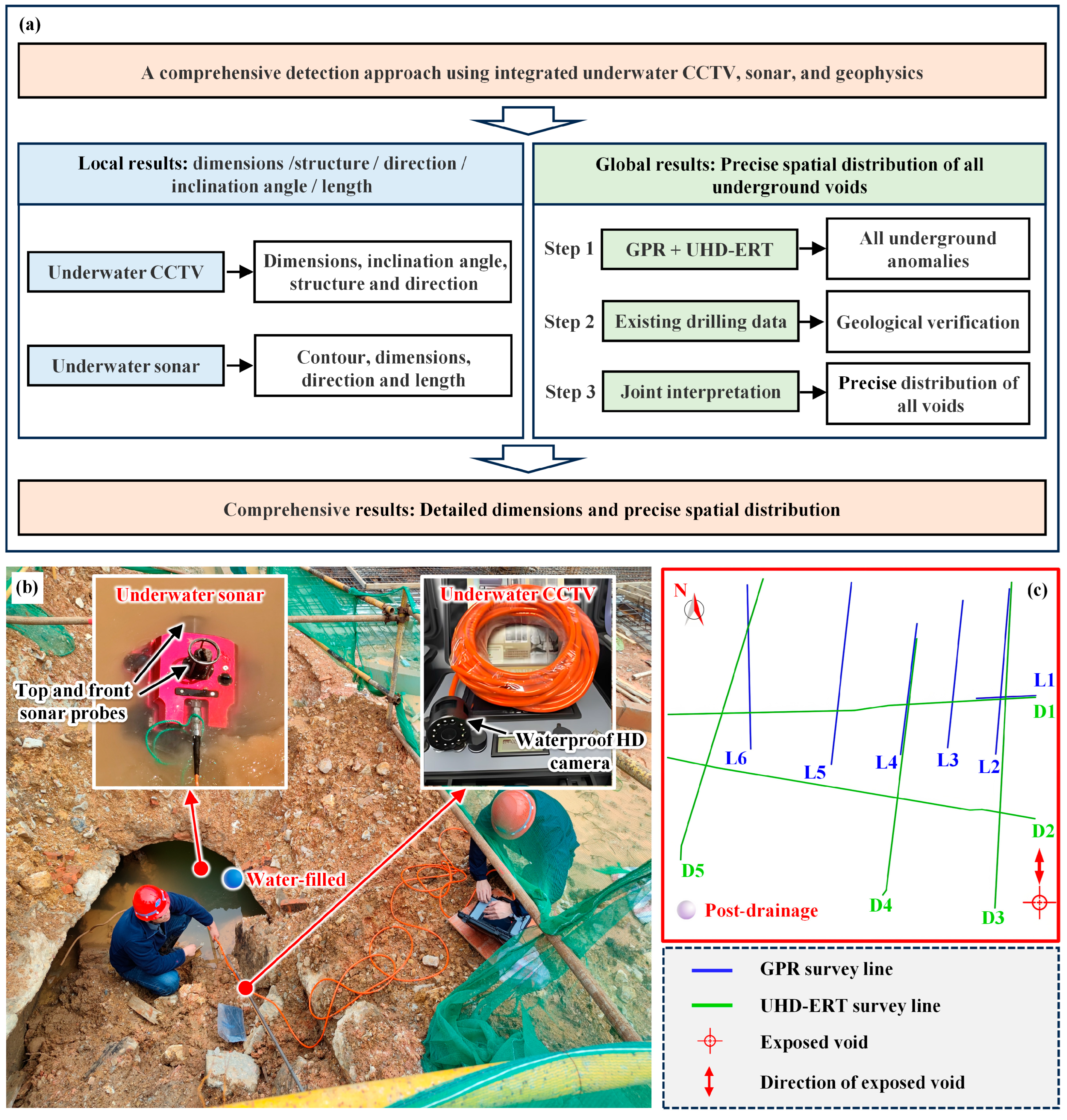
2.3.1. Underwater CCTV
2.3.2. Underwater Sonar
2.3.3. GPR
2.3.4. UHD-ERT
2.3.5. Anomaly Classification Criteria
3. Results
3.1. Underwater CCTV Results
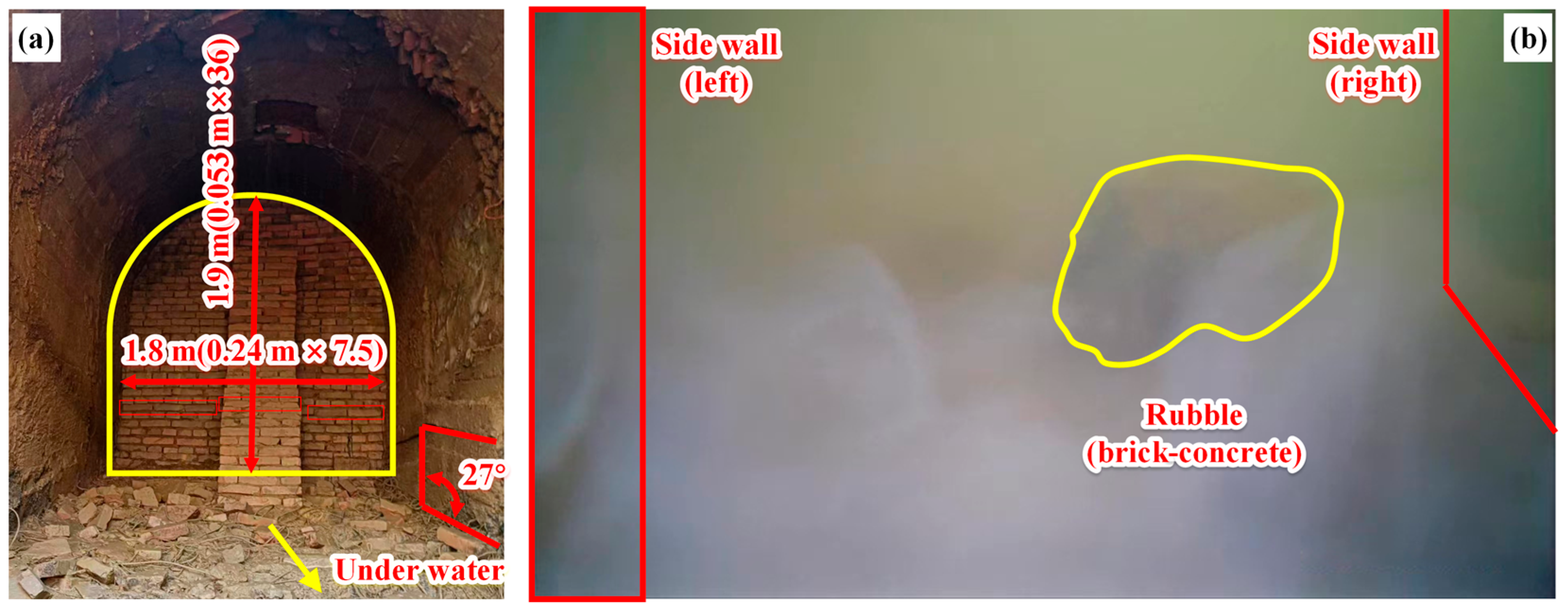
3.2. Underwater Sonar Results
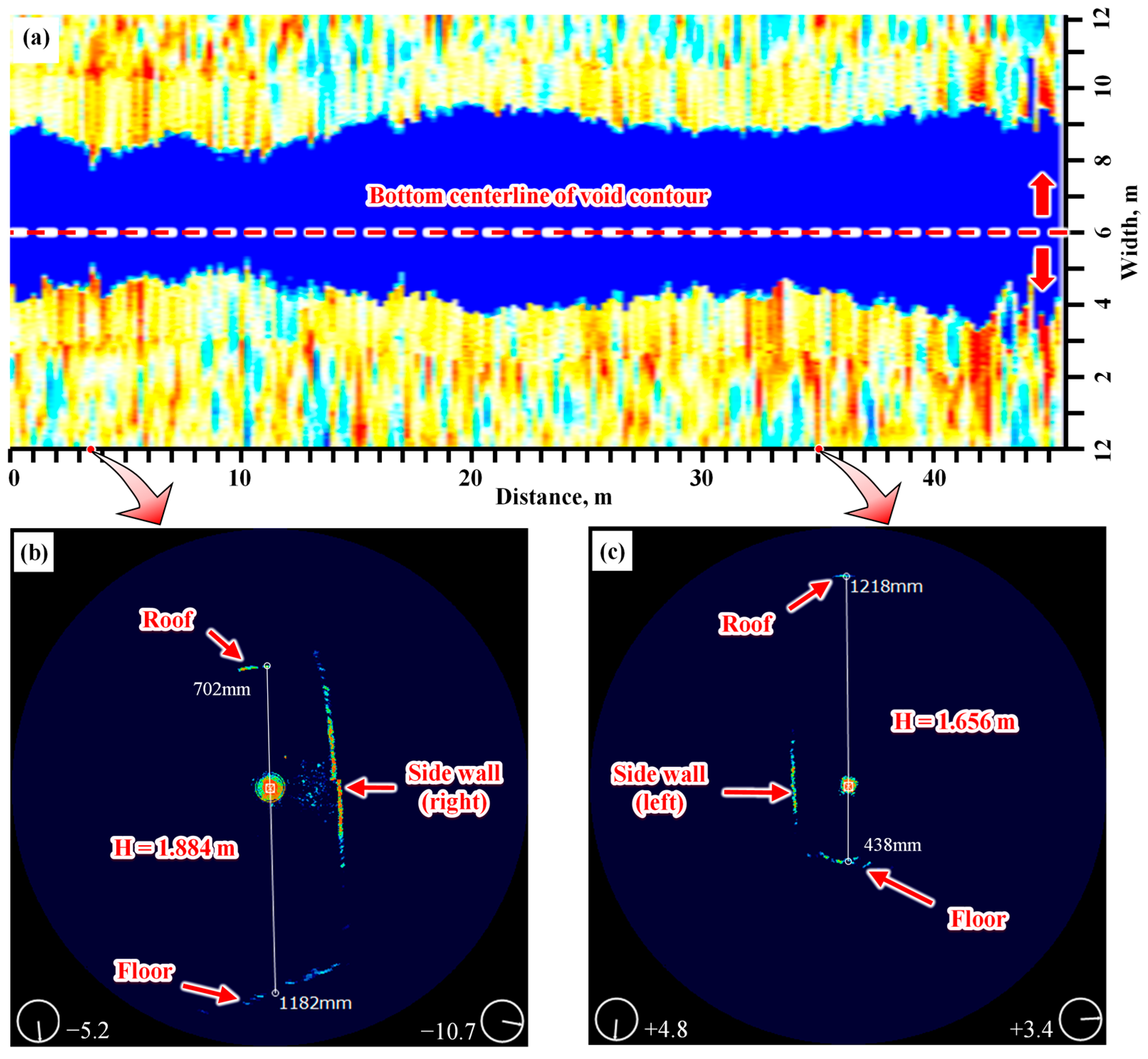
3.3. GPR Results

3.4. UHD-ERT Results
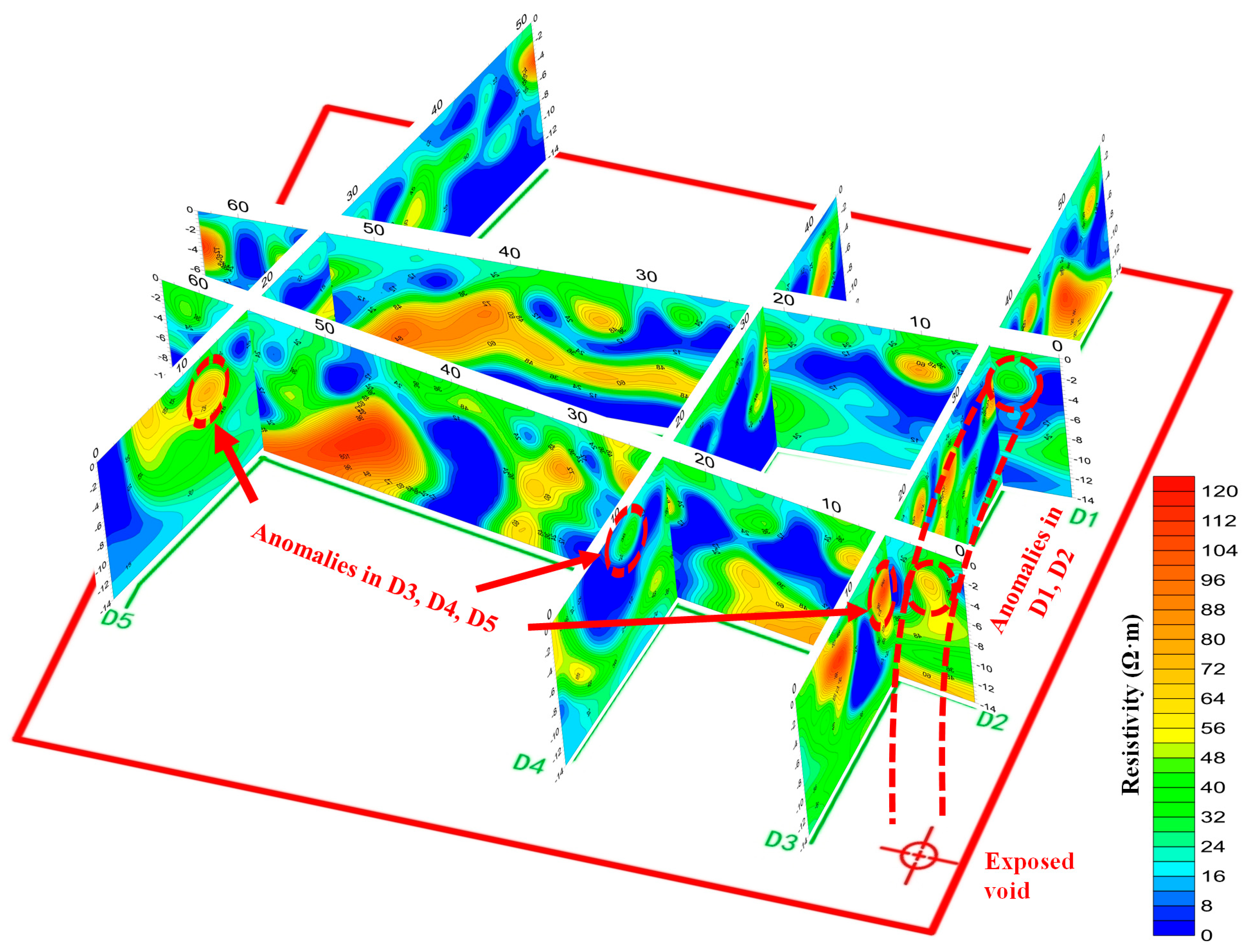
4. Comprehensive Interpretation and Discussion
4.1. Validation of UHD-ERT Results with Existing Drilling Data
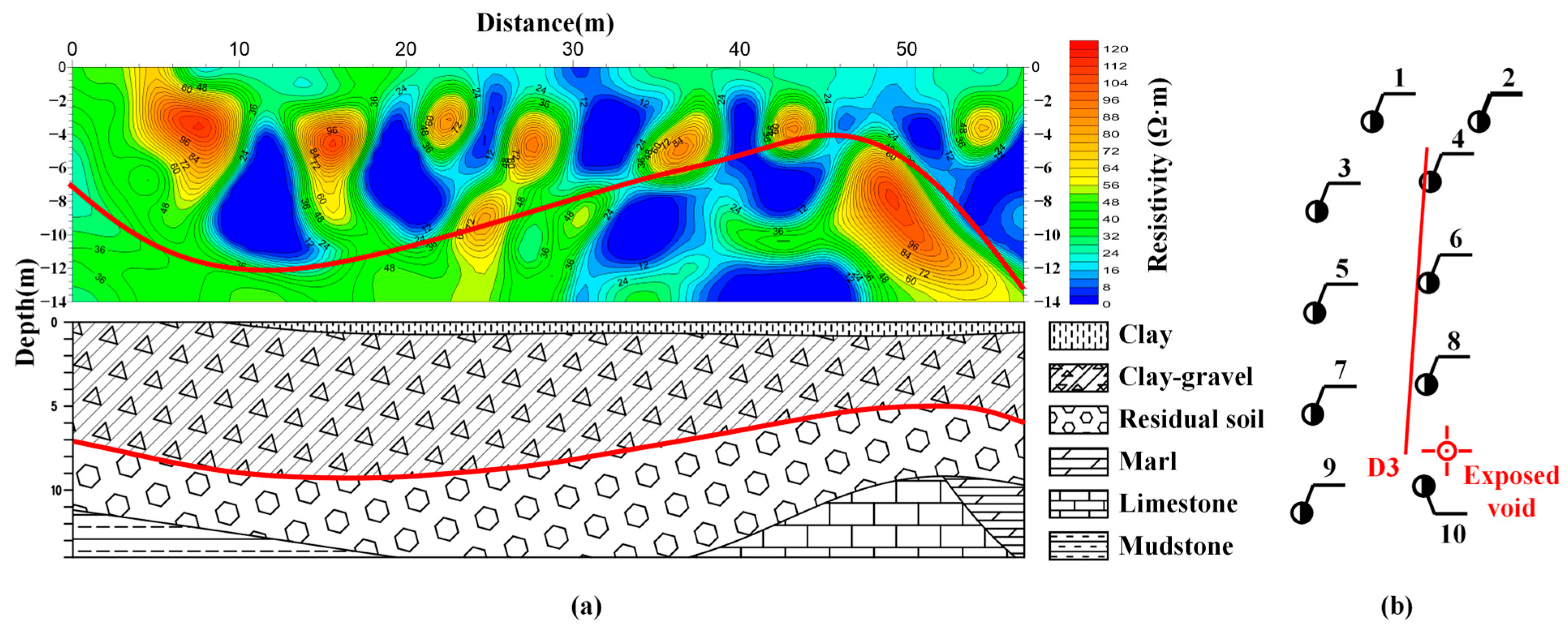
4.2. Joint Interpretation of Anomalous Signals from UHD-ERT and GPR
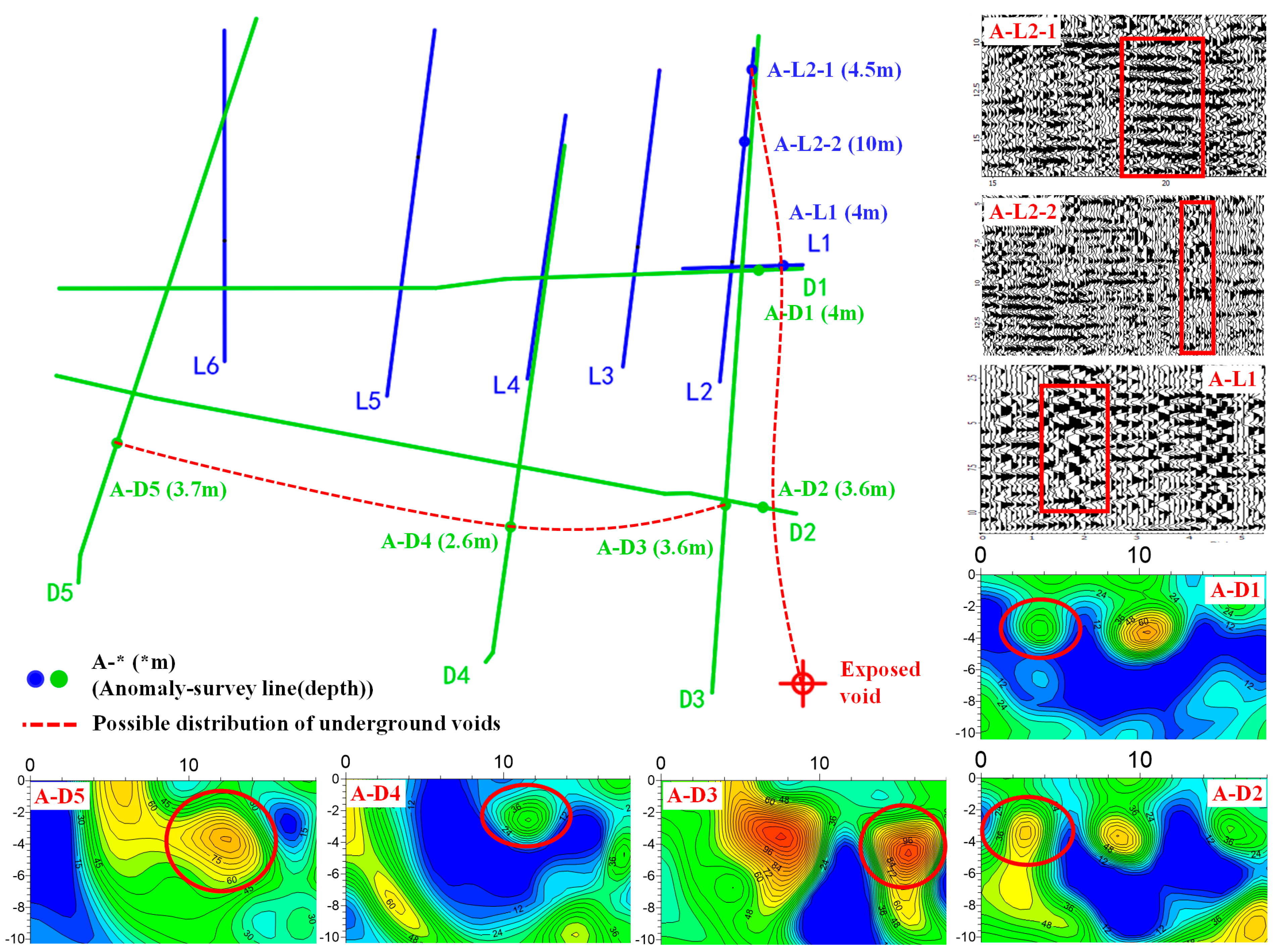
4.3. Comprehensive Results from Multiple Detection Methods

4.4. Discussion
4.4.1. Quantitative Drainage Effects on Geophysical Responses
4.4.2. Method Selection and Applicability
4.4.3. Contribution to Sustainable Development Goals (SDGs)
5. Conclusions
Author Contributions
Funding
Data Availability Statement
Acknowledgments
Conflicts of Interest
References
- Gutiérrez, F.; Parise, M.; De Waele, J.; Jourde, H. A Review on Natural and Human-Induced Geohazards and Impacts in Karst. Earth-Sci. Rev. 2014, 138, 61–88. [Google Scholar] [CrossRef]
- Cui, G.; Wei, J.; Feng, X.-T.; Liu, J.; Elsworth, D.; Chen, T.; Xiong, W. Preliminary Study on the Feasibility of Co-Exploitation of Coal and Uranium. Int. J. Rock Mech. Min. Sci. 2019, 123, 104098. [Google Scholar] [CrossRef]
- Veress, M. Karst Types and Their Karstification. J. Earth Sci. 2020, 31, 621–634. [Google Scholar] [CrossRef]
- Parise, M.; Lollino, P. A Preliminary Analysis of Failure Mechanisms in Karst and Man-Made Underground Caves in Southern Italy. Geomorphology 2011, 134, 132–143. [Google Scholar] [CrossRef]
- Fazio, N.L.; Perrotti, M.; Lollino, P.; Parise, M.; Vattano, M.; Madonia, G.; Di Maggio, C. A Three-Dimensional Back-Analysis of the Collapse of an Underground Cavity in Soft Rocks. Eng. Geol. 2017, 228, 301–311. [Google Scholar] [CrossRef]
- Chen, L.; de Borst, R. Analysis of Progressive Fracture in Fluid-Saturated Porous Medium Using Splines. Int. J. Numer. Methods Eng. 2023, 124, 264–281. [Google Scholar] [CrossRef]
- Zhao, Y.; Shi, Y.; Wu, F.; Sun, R.; Feng, H. Characterization of the Sinkhole Failure Mechanism Induced by Concealed Cave: A Case Study. Eng. Fail. Anal. 2021, 119, 105017. [Google Scholar] [CrossRef]
- Huang, F.; Zhao, L.; Ling, T.; Yang, X. Rock Mass Collapse Mechanism of Concealed Karst Cave beneath Deep Tunnel. Int. J. Rock Mech. Min. Sci. 2017, 91, 133–138. [Google Scholar] [CrossRef]
- Ruming, K.; McGuirk, P.; Mee, K. What Lies beneath? The Material Agency and Politics of the Underground in Urban Regeneration. Geoforum 2021, 126, 159–170. [Google Scholar] [CrossRef]
- Rizzo, E.; Capozzoli, L.; De Martino, G.; Grimaldi, S. Urban Geophysical Approach to Characterize the Subsoil of the Main Square in San Benedetto Del Tronto Town (Italy). Eng. Geol. 2019, 257, 105133. [Google Scholar] [CrossRef]
- Liu, R.; Sun, H.; Qin, J.; Zheng, Z. A Multi-Geophysical Approach to Assess Potential Sinkholes in an Urban Area. Eng. Geol. 2023, 318, 107100. [Google Scholar] [CrossRef]
- Pringle, J.K.; Ruffell, A.; Styles, P.; Stringfellow, M.; Stimpson, I.G.; Banham, S.G.; Wisniewski, K.D.; Owen, S.; Hobson, L.; Thompson, J. Forensic Geoscience Non-Invasive Detection and Characterisation of Underground Clandestine Complexes, Bunkers, Tunnels and Firing Ranges. Forensic Sci. Int. 2024, 359, 112033. [Google Scholar] [CrossRef] [PubMed]
- Thierry, P.; Debeblia, N.; Bitri, A. Geophysical and Geological Characterisation of Karst Hazards in Urban Environments: Application to Orléans (France). Bull. Eng. Geol. Environ. 2005, 64, 139–150. [Google Scholar] [CrossRef]
- Wadas, S.H.; Tanner, D.C.; Polom, U.; Krawczyk, C.M. Structural Analysis of S-Wave Seismics around an Urban Sinkhole: Evidence of Enhanced Dissolution in a Strike-Slip Fault Zone. Nat. Hazards Earth Syst. Sci. 2017, 17, 2335–2350. [Google Scholar] [CrossRef]
- Gritto, R.; Elnaiem, A.E.; Mohamed, F.A.; Sadooni, F. Seismic Detection and Characterization of a Man-Made Karst Analog—A Feasibility Study. Geophysics 2021, 86, WA35–WA48. [Google Scholar] [CrossRef]
- Wang, C.; Shi, Z.; Yang, W.; Wei, Y.; Huang, M. High-Resoultion Shallow Anomaly Characterization Using Cross-Hole P-and S-Wave Tomography. J. Appl. Geophys. 2022, 201, 104649. [Google Scholar] [CrossRef]
- Debeglia, N.; Bitri, A.; Thierry, P. Karst Investigations Using Microgravity and MASW; Application to Orléans, France. Near Surf. Geophys. 2006, 4, 215–225. [Google Scholar] [CrossRef]
- Jacob, T.; Pannet, P.; Beaubois, F.; Baltassat, J.-M.; Hannion, Y. Cavity Detection Using Microgravity in a Highly Urbanized Setting: A Case Study from Reims, France. J. Appl. Geophys. 2020, 179, 104113. [Google Scholar] [CrossRef]
- Tallini, M.; Lo Sardo, L.; Spadi, M. Seismic Site Characterisation of Red Soil and Soil-Building Resonance Effects in L’Aquila Downtown (Central Italy). Bull. Eng. Geol. Environ. 2020, 79, 4021–4034. [Google Scholar] [CrossRef]
- Kristekova, M.; Kristek, J.; Moczo, P.; Labak, P. The Finite-Interval Spectral Power Method for Detecting Underground Cavities Using Seismic Ambient Noise. Geophys. J. Int. 2021, 224, 945–960. [Google Scholar] [CrossRef]
- Chen, J.; Zhang, Y.; Lin, J. Fast Transdimensional Bayesian Transient Electromagnetic Imaging for Urban Underground Space Detection. Measurement 2022, 187, 110300. [Google Scholar] [CrossRef]
- Wang, H.; Fu, Z.; Wang, Y.; Tai, H.-M.; Chen, W. On-Site Calibration of Air-Coil Sensor for Transient Electromagnetic Exploration. Geophys. Prospect. 2019, 67, 1595–1610. [Google Scholar] [CrossRef]
- Fan, J.; Hou, E.; Jin, D.; Xi, Z.; Long, X.; Zhou, S.; Nan, S.; Liu, Y.; Guo, K.; Ning, D. Application of Opposing Coils Transient Electromagnetic Method in Urban Area with Metal Interference. J. Appl. Geophys. 2024, 228, 105467. [Google Scholar] [CrossRef]
- Carrière, S.D.; Chalikakis, K.; Sénéchal, G.; Danquigny, C.; Emblanch, C. Combining Electrical Resistivity Tomography and Ground Penetrating Radar to Study Geological Structuring of Karst Unsaturated Zone. J. Appl. Geophys. 2013, 94, 31–41. [Google Scholar] [CrossRef]
- Chamberlain, A.T.; Sellers, W.; Proctor, C.; Coard, R. Cave Detection in Limestone Using Ground Penetrating Radar. J. Archaeol. Sci. 2000, 27, 957–964. [Google Scholar] [CrossRef]
- Sato, M. Near Range Radar and Its Application to near Surface Geophysics and Disaster Mitigation. J. Earth Sci. 2015, 26, 858–863. [Google Scholar] [CrossRef]
- Martel, R.; Castellazzi, P.; Gloaguen, E.; Trépanier, L.; Garfias, J. ERT, GPR, InSAR, and Tracer Tests to Characterize Karst Aquifer Systems under Urban Areas: The Case of Quebec City. Geomorphology 2018, 310, 45–56. [Google Scholar] [CrossRef]
- Ducut, J.D.; Alipio, M.; Go, P.J.; Concepcion, R., II; Vicerra, R.R.; Bandala, A.; Dadios, E. A Review of Electrical Resistivity Tomography Applications in Underground Imaging and Object Detection. Displays 2022, 73, 102208. [Google Scholar] [CrossRef]
- Calamita, G.; Serlenga, V.; Stabile, T.A.; Gallipoli, M.R.; Bellanova, J.; Bonano, M.; Casu, F.; Vignola, L.; Piscitelli, S.; Perrone, A. An Integrated Geophysical Approach for Urban Underground Characterization: The Avigliano Town (Southern Italy) Case Study. Geomat. Nat. Hazards Risk 2019, 10, 412–432. [Google Scholar] [CrossRef]
- Wang, T.-P.; Chen, C.-C.; Tong, L.-T.; Chang, P.-Y.; Chen, Y.-C.; Dong, T.-H.; Liu, H.-C.; Lin, C.-P.; Yang, K.-H.; Ho, C.-J.; et al. Applying FDEM, ERT and GPR at a Site with Soil Contamination: A Case Study. J. Appl. Geophys. 2015, 121, 21–30. [Google Scholar] [CrossRef]
- Zhi, Q.; Deng, X.; Wu, J.; Li, X.; Wang, X.; Yang, Y.; Zhang, J. Inversion of IP-Affected TEM Responses and Its Application in High Polarization Area. J. Earth Sci. 2021, 32, 42–50. [Google Scholar] [CrossRef]
- Amanatidou, E.; Vargemezis, G.; Tsourlos, P. Combined Application of Seismic and Electrical Geophysical Methods for Karst Cavities Detection: A Case Study at the Campus of the New University of Western Macedonia, Kozani, Greece. J. Appl. Geophys. 2022, 196, 104499. [Google Scholar] [CrossRef]
- Chen, J.; Jia, W.; Zhang, Y.; Lin, J. Integrated TEM and GPR Data Interpretation for High-Resolution Measurement of Urban Underground Space. IEEE Trans. Instrum. Meas. 2021, 71, 5004409. [Google Scholar] [CrossRef]
- Castellanza, R.; Lollino, P.; Ciantia, M. A Methodological Approach to Assess the Hazard of Underground Cavities Subjected to Environmental Weathering. Tunn. Undergr. Space Technol. 2018, 82, 278–292. [Google Scholar] [CrossRef]
- Faraone, C.; Colantonio, F.; Vessia, G. Seismic Amplification Effects Induced by Ancient Shallow Cavities underneath the Urban Area of the Historical City Center of Chieti, Italy. Eng. Geol. 2023, 324, 107259. [Google Scholar] [CrossRef]
- Xu, J.; Lai, J.; Qiu, J.; Jiang, H.; Sun, H.; Tang, J.; Cui, G. Disasters Caused by Underground Water Pipe Leakage in Chinese Cities: Failure Modes, Influencing Factors and Prevention Countermeasures. Tunn. Undergr. Space Technol. 2026, 167, 107008. [Google Scholar] [CrossRef]
- Jiang, X.; Dai, J.; Zheng, Z.; Li, X.J.; Ma, X.; Zhou, W.; Lei, Q. An Overview on Karst Collapse Mechanism in China. Carbonates Evaporites 2024, 39, 71. [Google Scholar] [CrossRef]
- Gentili, F.; Madonna, S. Photogrammetry from UAV and Low-Cost Lidar for Sinkhole Hazard Mitigation in Urban Areas: Applications and Evaluations. Geographies 2024, 4, 343–362. [Google Scholar] [CrossRef]
- Saribudak, B.M.; Hauwert, N.M. Integrated Geophysical Investigations of Main Barton Springs, Austin, Texas, USA. J. Appl. Geophys. 2017, 138, 114–126. [Google Scholar] [CrossRef]
- Devrath, S.C.; Nag, A.; Pareek, S. Transforming Mining Regions through Sustainable Redevelopment with Urban Voids and Underground Housing. J. Min. Environ. 2025, 16, 1319–1342. [Google Scholar] [CrossRef]
- Zhang, N.; Sun, H.; Zhang, Z.; Liu, S.; Fan, Q. Image Subsurface Karst in Coastal Areas Using Gravity Gradient Method: A Case Study in Guangxi, China. J. Appl. Geophys. 2026, 244, 105990. [Google Scholar] [CrossRef]
- Baalousha, H.M. Groundwater Vulnerability Mapping of Qatar Aquifers. J. Afr. Earth Sci. 2016, 124, 75–93. [Google Scholar] [CrossRef]
- Frumkin, A.; Ezersky, M.; Al-Zoubi, A.; Akkawi, E.; Abueladas, A.-R. The Dead Sea Sinkhole Hazard: Geophysical Assessment of Salt Dissolution and Collapse. Geomorphology 2011, 134, 102–117. [Google Scholar] [CrossRef]
- Connair, D.P.; Murray, B.S. Karst Groundwater Basin Delineation, Fort Knox, Kentucky. Eng. Geol. 2002, 65, 125–131. [Google Scholar] [CrossRef]
- Zhang, M.; Wang, H.; Dong, Y.; Li, L.; Sun, P.; Zhang, G. Evaluation of Urban Underground Space Resources Using a Negative List Method: Taking Xi’an City as an Example in China. China Geol. 2020, 3, 124–136. [Google Scholar] [CrossRef]
- di Santolo, A.S.; Forte, G.; Santo, A. Analysis of Sinkhole Triggering Mechanisms in the Hinterland of Naples (Southern Italy). Eng. Geol. 2018, 237, 42–52. [Google Scholar] [CrossRef]
- Al Heib, M.; Duval, C.; Theoleyre, F.; Watelet, J.-M.; Gombert, P. Analysis of the Historical Collapse of an Abandoned Underground Chalk Mine in 1961 in Clamart (Paris, France). Bull. Eng. Geol. Environ. 2015, 74, 1001–1018. [Google Scholar] [CrossRef]
- Tan, F.; Tan, W.; Yan, F.; Qi, X.; Li, Q.; Hong, Z. Model Test Analysis of Subsurface Cavity and Ground Collapse Due to Broken Pipe Leakage. Appl. Sci. 2022, 12, 13017. [Google Scholar] [CrossRef]
- Cao, L.; Chen, Y.; Li, X.; Li, J.; Djamaluddine, I.; Lv, X. Impact of Soil Layer Distribution on the Morphology Characteristics of Underground Cavities. J. Perform. Constr. Facil. 2025, 39, 04025029. [Google Scholar] [CrossRef]
- Xiao, X.; Xu, M.; Ding, Q.; Kang, X.; Xia, Q.; Du, F. Experimental Study Investigating Deformation Behavior in Land Overlying a Karst Cave Caused by Groundwater Level Changes. Environ. Earth Sci. 2018, 77, 64. [Google Scholar] [CrossRef]
- Caselle, C.; Bonetto, S.; Comina, C.; Stocco, S. GPR Surveys for the Prevention of Karst Risk in Underground Gypsum Quarries. Tunn. Undergr. Space Technol. 2020, 95, 103137. [Google Scholar] [CrossRef]
- Li, Y.; Ren, Y.; Peng, S.S.; Cheng, H.; Wang, N.; Luo, J. Measurement of Overburden Failure Zones in Close-Multiple Coal Seams Mining. Int. J. Min. Sci. Technol. 2021, 31, 43–50. [Google Scholar] [CrossRef]
- Al-Fares, W.; Bakalowicz, M.; Guérin, R.; Dukhan, M. Analysis of the Karst Aquifer Structure of the Lamalou Area (Hérault, France) with Ground Penetrating Radar. J. Appl. Geophys. 2002, 51, 97–106. [Google Scholar] [CrossRef]
- Liu, H.; Yue, Y.; Liu, C.; Spencer, B.F.; Cui, J. Automatic Recognition and Localization of Underground Pipelines in GPR B-Scans Using a Deep Learning Model. Tunn. Undergr. Space Technol. 2023, 134, 104861. [Google Scholar] [CrossRef]
- Lai, W.W.-L.; Dérobert, X.; Annan, P. A Review of Ground Penetrating Radar Application in Civil Engineering: A 30-Year Journey from Locating and Testing to Imaging and Diagnosis. NDT E Int. 2018, 96, 58–78. [Google Scholar] [CrossRef]
- Diallo, M.C.; Cheng, L.Z.; Rosa, E.; Gunther, C.; Chouteau, M. Integrated GPR and ERT Data Interpretation for Bedrock Identification at Cléricy, Québec, Canada. Eng. Geol. 2019, 248, 230–241. [Google Scholar] [CrossRef]
- Lazzari, M.; Loperte, A.; Perrone, A. Near Surface Geophysics Techniques and Geomorphological Approach to Reconstruct the Hazard Cave Map in Historical and Urban Areas. Adv. Geosci. 2010, 24, 35–44. [Google Scholar] [CrossRef]
- Čeru, T.; Šegina, E.; Knez, M.; Benac, Č.; Gosar, A. Detecting and Characterizing Unroofed Caves by Ground Penetrating Radar. Geomorphology 2018, 303, 524–539. [Google Scholar] [CrossRef]
- Dahlin, T.; Zhou, B. A Numerical Comparison of 2D Resistivity Imaging with 10 Electrode Arrays. Geophys. Prospect. 2004, 52, 379–398. [Google Scholar] [CrossRef]
- Martorana, R.; Capizzi, P.; D’Alessandro, A.; Luzio, D. Comparison of Different Sets of Array Configurations for Multichannel 2D ERT Acquisition. J. Appl. Geophys. 2017, 137, 34–48. [Google Scholar] [CrossRef]
- Candansayar, M.E. Two-Dimensional Individual and Joint Inversion of Three- and Four-Electrode Array Dc Resistivity Data. J. Geophys. Eng. 2008, 5, 290–300. [Google Scholar] [CrossRef]
- Bharti, A.K.; Pal, S.K.; Priyam, P.; Pathak, V.K.; Kumar, R.; Ranjan, S.K. Detection of Illegal Mine Voids Using Electrical Resistivity Tomography: The Case-Study of Raniganj Coalfield (India). Eng. Geol. 2016, 213, 120–132. [Google Scholar] [CrossRef]
- Cheng, G.; Xu, W.; Shi, B.; Wu, J.; Sun, B.; Zhu, H. Experimental Study on the Deformation and Failure Mechanism of Overburden Rock during Coal Mining Using a Comprehensive Intelligent Sensing Method. J. Rock Mech. Geotech. Eng. 2022, 14, 1626–1641. [Google Scholar] [CrossRef]
- Prakash, A.; Bharti, A.K.; Verma, A. Unearthing Underground Mining-Induced Strata Disturbance by Electrical Resistivity Tomography Interpretation. Environ. Eng. Geosci. 2022, 28, 361–369. [Google Scholar] [CrossRef]
- Pasierb, B.; Gajek, G.; Urban, J.; Nawrocki, W. Integrated Geophysical and Geomorphological Studies of Caves in Calcarenite Limestones (Jaskinia Pod Świecami Cave, Poland). Surv. Geophys. 2024, 45, 663–694. [Google Scholar] [CrossRef]
- Leopold, M.; Gupanis-Broadway, C.; Baker, A.; Hankin, S.; Treble, P. Time Lapse Electric Resistivity Tomography to Portray Infiltration and Hydrologic Flow Paths from Surface to Cave. J. Hydrol. 2021, 593, 125810. [Google Scholar] [CrossRef]
- Bharti, A.K.; Prakash, A.; Verma, A.; Singh, K.K.K. Assessment of Hydrological Condition in Strata Associated with Old Mine Working during and Post-Monsoon Using Electrical Resistivity Tomography: A Case Study. Bull. Eng. Geol. Environ. 2021, 80, 5159–5166. [Google Scholar] [CrossRef]
- Maillol, J.M.; Seguin, M.-K.; Gupta, O.P.; Akhauri, H.M.; Sen, N. Electrical Resistivity Tomography Survey for Delineating Uncharted Mine Galleries in West Bengal, India. Geophys. Prospect. 1999, 47, 103–116. [Google Scholar] [CrossRef]
- Roth, M.; Nyquist, J. Evaluation of Multi-Electrode Earth Resistivity Testing in Karst. Geotech. Test. J. 2003, 26, 167–178. [Google Scholar] [CrossRef]
- Negri, S.; Barbolla, D.F. Challenges in the Detection of Water-Filled Cavities in Karst Environments Using Electrical Resistivity Tomography. Geosciences 2025, 15, 349. [Google Scholar] [CrossRef]
- Rahimi, M.; Wood, C.M.; Kallivokas, L.F. A Comparative Study of Using Geophysical Methods for Imaging Subsurface Voids of Various Sizes and at Different Depths. Eng. Geol. 2024, 341, 107711. [Google Scholar] [CrossRef]
- Fasani, G.B.; Bozzano, F.; Cardarelli, E.; Cercato, M. Underground Cavity Investigation within the City of Rome (Italy): A Multi-Disciplinary Approach Combining Geological and Geophysical Data. Eng. Geol. 2013, 152, 109–121. [Google Scholar] [CrossRef]
- Argote, D.L.; Tejero-Andrade, A.; Cárdenas-Soto, M.; Cifuentes-Nava, G.; Chávez, R.E.; Hernández-Quintero, E.; García-Serrano, A.; Ortega, V. Designing the Underworld in Teotihuacan: Cave Detection beneath the Moon Pyramid by ERT and ANT Surveys. J. Archaeol. Sci. 2020, 118, 105141. [Google Scholar] [CrossRef]
- Fu, Z.; Ren, Z.; Hua, X.; Shi, Y.; Chen, H.; Chen, C.; Li, Y.; Tang, J. Identification of Underground Water-Bearing Caves in Noisy Urban Environments (Wuhan, China) Using 3D Electrical Resistivity Tomography Techniques. J. Appl. Geophys. 2020, 174, 103966. [Google Scholar] [CrossRef]
- Caruana, J.; Wood, J.; Nocerino, E.; Menna, F.; Micallef, A.; Gambin, T. Reconstruction of the Collapse of the ‘Azure Window’ Natural Arch via Photogrammetry. Geomorphology 2022, 408, 108250. [Google Scholar] [CrossRef]
- Zhang, S.; Zhao, S.; An, D.; Liu, J.; Wang, H.; Feng, Y.; Li, D.; Zhao, R. Visual SLAM for Underwater Vehicles: A Survey. Comput. Sci. Rev. 2022, 46, 100510. [Google Scholar] [CrossRef]
- Mallios, A.; Ridao, P.; Ribas, D.; Carreras, M.; Camilli, R. Toward Autonomous Exploration in Confined Underwater Environments. J. Field Robot. 2016, 33, 994–1012. [Google Scholar] [CrossRef]
- Ma, Y.; Wang, S.; Xin, G.; Li, B.; Fang, H.; Lei, J.; Du, X.; Wang, N.; Di, D. A State-of-the-Art-Review of Underground Concrete Sewage Pipelines Detection Technologies. Measurement 2025, 242, 116268. [Google Scholar] [CrossRef]
- Rayhana, R.; Jiao, Y.; Zaji, A.; Liu, Z. Automated Vision Systems for Condition Assessment of Sewer and Water Pipelines. IEEE Trans. Autom. Sci. Eng. 2021, 18, 1861–1878. [Google Scholar] [CrossRef]
- De Waele, J.; Fabbri, S.; Santagata, T.; Chiarini, V.; Columbu, A.; Pisani, L. Geomorphological and Speleogenetical Observations Using Terrestrial Laser Scanning and 3D Photogrammetry in a Gypsum Cave (Emilia Romagna, N. Italy). Geomorphology 2018, 319, 47–61. [Google Scholar] [CrossRef]
- Parrott, C.; Dodd, T.J.; Boxall, J.; Horoshenkov, K. Simulation of the Behavior of Biologically-Inspired Swarm Robots for the Autonomous Inspection of Buried Pipes. Tunn. Undergr. Space Technol. 2020, 101, 103356. [Google Scholar] [CrossRef]
- Dirksen, J.; Clemens, F.H.L.R.; Korving, H.; Cherqui, F.; Le Gauffre, P.; Ertl, T.; Plihal, H.; Müller, K.; Snaterse, C.T.M. The Consistency of Visual Sewer Inspection Data. Struct. Infrastruct. Eng. 2011, 9, 214–228. [Google Scholar] [CrossRef]
- Calantropio, A.; Chiabrando, F. Underwater Cultural Heritage Documentation Using Photogrammetry. J. Mar. Sci. Eng. 2024, 12, 413. [Google Scholar] [CrossRef]
- Song, Y.; She, M.; Köser, K. Advanced Underwater Image Restoration in Complex Illumination Conditions. ISPRS J. Photogramm. Remote Sens. 2024, 209, 197–212. [Google Scholar] [CrossRef]
- Zhou, Y.; Chen, H.; Gao, L.; Li, G.; Chen, Y. An Automatic Method of Siltation Depth Detection and 3D Modeling in Water-Filled Sewer Pipelines Based on Sonar Point Clouds. Measurement 2025, 242, 115954. [Google Scholar] [CrossRef]
- Li, C.; Chen, K.; Li, H.; Luo, H. Multisensor Data Fusion Approach for Sediment Assessment of Sewers in Operation. Eng. Appl. Artif. Intell. 2024, 132, 107965. [Google Scholar] [CrossRef]
- Moisan, E.; Charbonnier, P.; Foucher, P.; Grussenmeyer, P.; Guillemin, S.; Koehl, M. Adjustment of Sonar and Laser Acquisition Data for Building the 3D Reference Model of a Canal Tunnel. Sensors 2015, 15, 31180–31204. [Google Scholar] [CrossRef]
- Wang, Z.; Chen, F.; Li, H.; Huang, G.; Yang, C. Development and Experimental Study of China’s First Pressurized Cavern Testing Device for Salt Caverns. Measurement 2026, 257, 118930. [Google Scholar] [CrossRef]
- Deiana, R.; Bonetto, J.; Mazzariol, A. Integrated Electrical Resistivity Tomography and Ground Penetrating Radar Measurements Applied to Tomb Detection. Surv. Geophys. 2018, 39, 1081–1105. [Google Scholar] [CrossRef]
- Zhe, J.; Greenhalgh, S.; Marescot, L. Multichannel, Full Waveform and Flexible Electrode Combination Resistivity-Imaging System. Geophysics 2007, 72, F57–F64. [Google Scholar] [CrossRef]
- Lei, X.; Li, Z.; Zhe, J. Applications and Research of the High Resolution Resistivity Method in Explovation of Caves, Mined Regions and Karst Region. Prog. Geophys. 2009, 24, 340–347. (In Chinese) [Google Scholar]
- Boddice, D.; Atkins, P.; Rodgers, A.; Metje, N.; Goncharenko, Y.; Chapman, D. A Novel Approach to Reduce Environmental Noise in Microgravity Measurements Using a Scintrex CG5. J. Appl. Geophys. 2018, 152, 221–235. [Google Scholar] [CrossRef]
- Pazzi, V.; Di Filippo, M.; Di Nezza, M.; Carlà, T.; Bardi, F.; Marini, F.; Fontanelli, K.; Intrieri, E.; Fanti, R. Integrated Geophysical Survey in a Sinkhole-Prone Area: Microgravity, Electrical Resistivity Tomographies, and Seismic Noise Measurements to Delimit Its Extension. Eng. Geol. 2018, 243, 282–293. [Google Scholar] [CrossRef]
- Maurer, H.; Greenhalgh, S.A.; Manukyan, E.; Marelli, S.; Green, A.G. Receiver-Coupling Effects in Seismic Waveform Inversions. Geophysics 2012, 77, R57–R63. [Google Scholar] [CrossRef]
- Rahimi, S.; Wood, C.M.; Teague, D.P. Performance of Different Transformation Techniques for MASW Data Processing Considering Various Site Conditions, Near-Field Effects, and Modal Separation. Surv. Geophys. 2021, 42, 1197–1225. [Google Scholar] [CrossRef]
- Delefortrie, S.; Hanssens, D.; De Smedt, P. Low Signal-to-Noise FDEM in-Phase Data: Practical Potential for Magnetic Susceptibility Modelling. J. Appl. Geophys. 2018, 152, 17–25. [Google Scholar] [CrossRef]
- McLachlan, P.; Christiensen, N.B.; Grombacher, D.; Christiansen, A.V. Evaluating the Impact of Correlated Noise for Time-lapse Transient Electromagnetic (TEM) Monitoring Studies. Near Surf. Geophys. 2023, 21, 333–342. [Google Scholar] [CrossRef]
- Nabighian, M.N.; Grauch, V.J.S.; Hansen, R.O.; LaFehr, T.R.; Li, Y.; Peirce, J.W.; Phillips, J.D.; Ruder, M.E. The Historical Development of the Magnetic Method in Exploration. Geophysics 2005, 70, 33ND–61ND. [Google Scholar] [CrossRef]
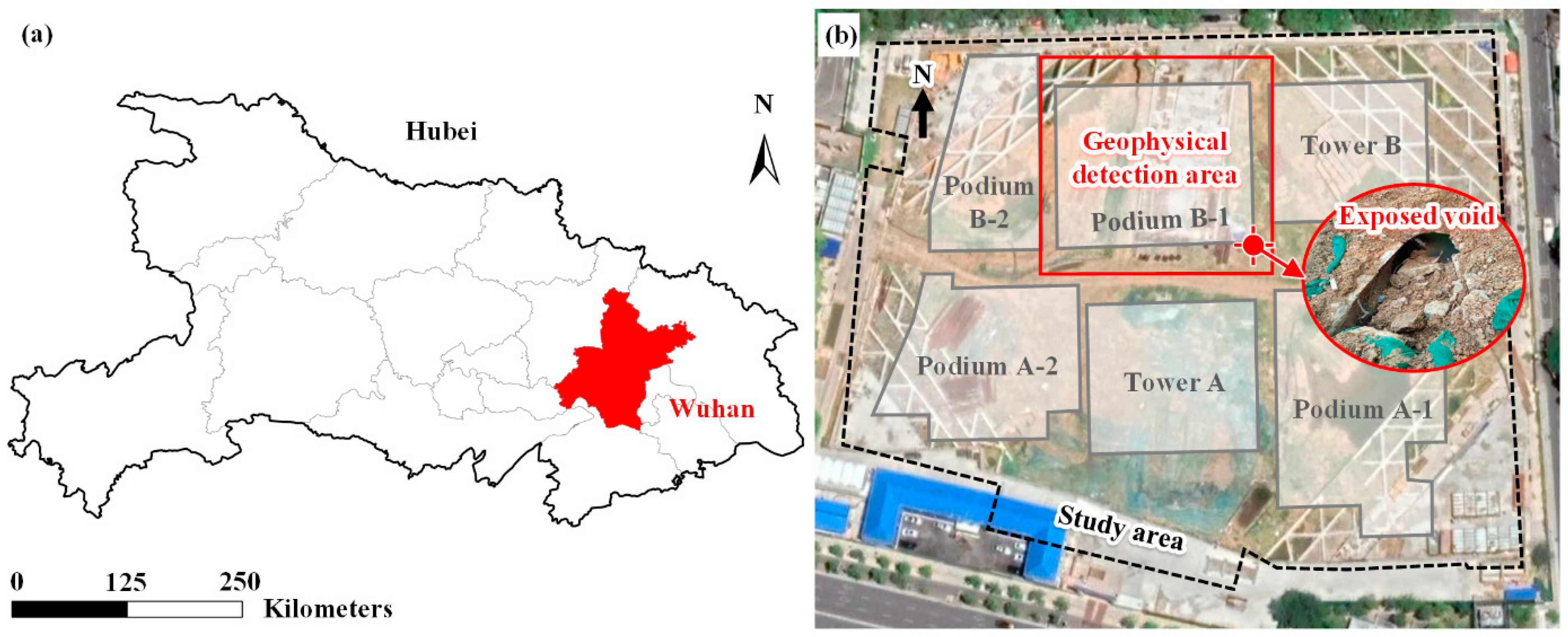

| Method | Strengths | Limitations | Access Needs | Sensitivity to Water |
|---|---|---|---|---|
| CCTV | Intuitive imagery; precise defect location | Line-of-sight only; requires entry; fails in turbid water | Manhole/ borehole | High |
| Underwater Sonar | Operates in zero-visibility; good geometric accuracy | Requires water-filled cavity; pose/odometry drift | Manhole/ borehole | Water-dependent |
| GPR | High resolution; rapid areal coverage; effective for shallow small voids | Highly sensitive to moisture/clay; limited depth (<~10 m typical); EM/utility clutter | Surface antenna scanning | High |
| ERT | Greater depth range; detects air- and water-filled voids | Limited resolution; urban layout constraints; non-unique resistivity anomalies | Surface electrode layout | Lower |
| Day | Activity | Water State | Site Moisture | Method/Sensor | Primary Outputs | Primary Outputs |
|---|---|---|---|---|---|---|
| 0 | Exposure of historic tunnel | Partially water-filled | Baseline | Visual inspection | Breach location; initial geometry | Figure 1b |
| 1 | Rainfall event | Water-filled | Elevated | Site log | Moisture context | — |
| 3 | Underwater CCTV (dry + submerged) | Water-filled | Elevated | HD camera a (1920 × 1080) | Arch shape; inclination; sealed wall; scale-calibrated dimensions | Figure 2b and Figure 3 |
| 3 | Underwater sonar scan (full-length) | Water-filled | Elevated | X7-DS robot b, dual 1 MHz sonar | Trajectory; internal contour; roof/floor heights; sealed ends distance | Figure 2b and Figure 4 |
| 4 | Pumping of exposed chamber | Drained | Decreasing | Pump/drain log | Lowered water level | — |
| 5 | Post-drainage check (fair weather) | Drained | Near-baseline | Visual inspection | Confirm low water; plan geophysics | — |
| 6 | GPR acquisition | Drained | Near-baseline | Zond-12e c, 75–150 MHz | Void-type signature on L1; anomalies on L2 | Figure 2c and Figure 5 |
| 6 | UHD-ERT acquisition | Drained | Near-baseline | FlashRES-64 d, 1 m electrode spacing | Closed high-resistivity loops on D1–D2 | Figure 2c and Figure 6 |
| 7 | Integration and decision | Drained | Baseline | GIS/CAD + boreholes | Final map: only exposed void present | Figure 7, Figure 8 and Figure 9 |
| Symbol | Meaning | Representative Value | Basis |
|---|---|---|---|
| ϕ | Porosity | 0.25–0.35 | Clay–gravel/residual soils |
| m | Cementation exponent | 1.5–2.0 | Unconsolidated sands/gravels |
| n | Saturation exponent | ≈2(1.8–2.0) | Common for sands/gravels |
| Mineral permittivity | 4–7 | Quartz–clay mixtures | |
| Water permittivity | ~80 | Room temperature | |
| Near-saturated saturation | 0.9–1.0 | Post-rain, pre-drainage | |
| Drained saturation | 0.5–0.7 | Two fair-weather days + pumping | |
| UHD-ERT resistivity contrast | 1.8–3.0 | Archie ratio with n ≈ 2 | |
| (sat→drained) | Effective permittivity | ~20–30→~11–14 | CRIM with ϕ range |
| v (sat→drained) | GPR velocity | ~0.06–0.07→0.09 m/ns | CRIM + L1 fit |
| GPR attenuation length | Penetration/contrast | ~1.4–1.7× increase |
Disclaimer/Publisher’s Note: The statements, opinions and data contained in all publications are solely those of the individual author(s) and contributor(s) and not of MDPI and/or the editor(s). MDPI and/or the editor(s) disclaim responsibility for any injury to people or property resulting from any ideas, methods, instructions or products referred to in the content. |
© 2025 by the authors. Licensee MDPI, Basel, Switzerland. This article is an open access article distributed under the terms and conditions of the Creative Commons Attribution (CC BY) license (https://creativecommons.org/licenses/by/4.0/).
Share and Cite
Zhou, J.; Feng, W.; Guan, P.; Liu, J.; Zhang, H.; Wang, Z. Comprehensive Detection of Groundwater-Affected Ancient Underground Voids During Old Town Renewal: A Case Study from Wuhan, China. Water 2025, 17, 3356. https://doi.org/10.3390/w17233356
Zhou J, Feng W, Guan P, Liu J, Zhang H, Wang Z. Comprehensive Detection of Groundwater-Affected Ancient Underground Voids During Old Town Renewal: A Case Study from Wuhan, China. Water. 2025; 17(23):3356. https://doi.org/10.3390/w17233356
Chicago/Turabian StyleZhou, Jie, Wei Feng, Peng Guan, Junsheng Liu, Huilan Zhang, and Zixiong Wang. 2025. "Comprehensive Detection of Groundwater-Affected Ancient Underground Voids During Old Town Renewal: A Case Study from Wuhan, China" Water 17, no. 23: 3356. https://doi.org/10.3390/w17233356
APA StyleZhou, J., Feng, W., Guan, P., Liu, J., Zhang, H., & Wang, Z. (2025). Comprehensive Detection of Groundwater-Affected Ancient Underground Voids During Old Town Renewal: A Case Study from Wuhan, China. Water, 17(23), 3356. https://doi.org/10.3390/w17233356







